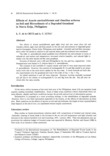Effects of Acacia auriculiformis and Gmelina arborea on Soil and Microclimate of a Degraded Grassland in Nueva Ecija, Philippines
JIRCAS international symposium series
| ISSN | 13406108 |
|---|---|
| 書誌レコードID(総合目録DB) | AA1100908X |

本文フルテキスト
intlsymp-1_46-54.pdf304.03 KB
The effects of Acacia auriculiformis aged eight (Aas) and two years (Aa2) old and Gmelina arborea eight year-old (Gas) stands on the soil and microclimate of degraded grassland in Carranglan, Nueva Ecija, Philippines were studied. Litterfall and leaf litter decomposition under the stands in relation to soil nutrient status and microclimate were evaluated.
The older A. auriculiformis stand modified more efficiently the microclimate in terms of reduced air and surface soil temperature, increased relative humidity, and reduced light intensity over the other stands and the open grassland.
Amounts of litterfall were 1,338 and 405.Skg/ha/yr for Aas and Gas, respectively. Litter disappearance was fastest in G. arborea than in A. auriculiformis.
The contents of soil available P, organic matter and total N were most improved under A. auriculiformis. However, the contents of exchangeable K, Ca and Mg tended to be temporarily lower due to the more active uptake by the Aas trees. A trend towards soil bulk density improvement over the grassland soil was in the order of Aas > Aa2 > Gas.
No initial variations in soil pH were observed. However, burning markedly increased soil pH due to the release of exchangeable K, Ca and Mg from the ash. But pH later declined after the rainy months.
The older A. auriculiformis stand modified more efficiently the microclimate in terms of reduced air and surface soil temperature, increased relative humidity, and reduced light intensity over the other stands and the open grassland.
Amounts of litterfall were 1,338 and 405.Skg/ha/yr for Aas and Gas, respectively. Litter disappearance was fastest in G. arborea than in A. auriculiformis.
The contents of soil available P, organic matter and total N were most improved under A. auriculiformis. However, the contents of exchangeable K, Ca and Mg tended to be temporarily lower due to the more active uptake by the Aas trees. A trend towards soil bulk density improvement over the grassland soil was in the order of Aas > Aa2 > Gas.
No initial variations in soil pH were observed. However, burning markedly increased soil pH due to the release of exchangeable K, Ca and Mg from the ash. But pH later declined after the rainy months.
| 作成者 | L. U. de la CRUZ A. C. LUNA |
|---|---|
| 公開者 | Japan International Research Center for Agricultural Sciences |
| オンライン掲載日 | |
| 号 | 1 |
| 開始ページ | 46 |
| 終了ページ | 54 |
| 言語 | eng |
